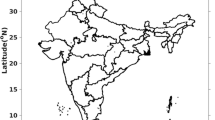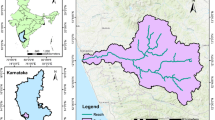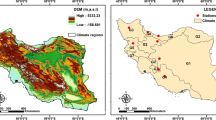Abstract
Global numerical weather prediction (NWP) models, including ensemble prediction systems (EPS), are routinely used by the forecasters to predict tropical cyclone (TC) tracks and intensity. However, due to computational restrictions, the EPSs are usually of coarse resolution, which results in poor prediction of TC intensity. The bias in the model predicting maximum sustained winds (MSW) and central pressure (CP) is large when TCs are intense. This article describes the suitability of machine learning (ML) techniques to reduce errors in TC intensity forecasts obtained from the National Centre for Medium Range Weather Forecasting (NCMRWF) Ensemble Prediction System (NEPS) over the North Indian Ocean (NIO). Four different ML techniques, namely, Multivariate Linear Regression (MLR), Support Vector Regression (SVR), Random Forest (RF), and eXtreme Gradient Boost (XGB), have been used for the bias correction (BC) of mean MSW and CP, while the spread of ensemble members has been retained. The study is based on 20 TC cases formed over the NIO during 2018–21. The best track (BT) information from the India Meteorological Department (IMD) has been used for training the ML models and verifying them. The results show that XGB (for CP) and RF (for MSW) ML techniques are superior to MLR and SVR methods. The statistically significant reduction (at 99% CI) in mean absolute error (MAE) (root mean square error (RMSE) of mean MSW and CP while using the best algorithm are 30 (33)% and 63 (55)%, respectively. The correlation coefficient for CP increases from 0.58 to 0.93 and that for MSW from 0.60 to 0.75. The probabilistic verification of bias-corrected ensemble members also suggests that the RF- and XGB-based models have better reliability and ROC compared to the raw and other models for MSW and CP, respectively.









Similar content being viewed by others
Data availability
The best track data is made available by India Meteorological Department (IMD) and is in public domain. The NCMRWF model data can be made available by the authors upon request.
References
Aijaz, S., Kepert, J. D., Ye, H., Huang, Z., & Hawksford, A. (2019). Bias correction of tropical cyclone parameters in the ECMWF ensemble prediction system in Australia. Monthly Weather Review, 147(11), 4261–4285. https://doi.org/10.1175/MWR-D-18-0377.1
Bishop, C. H., Etherton, B. J., & Majumdar, S. J. (2001). Adaptive sampling with the ensemble transform kalman filter. Part I: Theoretical aspects. Monthly Weather Review, 129(3), 420–436. https://doi.org/10.1175/1520-0493(2001)129%3c0420:ASWTET%3e2.0.CO;2
Breiman, L. (2001). Random forests. Machine Learning, 45(1), 5–32. https://doi.org/10.1023/A:1010933404324
Brier, G. W. (1950). Verification of forecasts expressed in terms of probability. Monthly Weather Review, 78(1), 1–3. https://doi.org/10.1175/1520-0493(1950)078%3c0001:VOFEIT%3e2.0.CO;2
Bright, D. R., & Mullen, S. L. (2002). Short-range ensemble forecasts of precipitation during the southwest monsoon. Weather and Forecasting, 17(5), 1080–1100. https://doi.org/10.1175/1520-0434(2002)017%3c1080:SREFOP%3e2.0.CO;2
Buizza, R. (2019). Introduction to the special issue on “25 years of ensemble forecasting.” Quarterly Journal of the Royal Meteorological Society, 145(S1), 1–11. https://doi.org/10.1002/qj.3370
Chan, M. H. K., Wong, W. K., & Au-Yeung, K. C. (2021). Machine learning in calibrating tropical cyclone intensity forecast of ECMWF EPS. Meteorological Applications. https://doi.org/10.1002/met.2041
Chaudhuri, S., Dutta, D., Goswami, S., & Middey, A. (2013). Intensity forecast of tropical cyclones over North Indian Ocean using multilayer perceptron model: Skill and performance verification. Natural Hazards, 65(1), 97–113. https://doi.org/10.1007/s11069-012-0346-7
Chen, R., Zhang, W., & Wang, X. (2020a). Machine learning in tropical cyclone forecast modeling: A review. Atmosphere, 11(7), 676. https://doi.org/10.3390/atmos11070676
Chen, T., He, T., Benesty, M., Khotilovich, V., Tang, Y., Cho, H., Chen, K., Mitchell, R., Cano, I., Zhou, T., Li, M., Xie, J., Lin, M., Geng, Y., & Li, Y., (2020b). xgboost: Extreme Gradient Boosting. R package version 1.2.0.1. https://CRAN.R-project.org/package=xgboost. Accessed 1 June 2022.
Das, A. K., Rama Rao, Y. V., Tallapragada, V., Zhang, Z., Roy Bhowmik, S. K., & Sharma, A. (2015). Evaluation of the Hurricane Weather Research and Forecasting (HWRF) model for tropical cyclone forecasts over the North Indian Ocean (NIO). Natural Hazards, 75(2), 1205-1221. https://doi.org/10.1007/s11069-014-1362-6.
DeMaria, M., Knaff, J. A., & Kaplan, J. (2006). On the decay of tropical cyclone winds crossing narrow landmasses. Journal of Applied Meteorology and Climatology, 45(3), 491–499. https://doi.org/10.1175/JAM2351.1
DeMaria, M., Sampson, C. R., Knaff, J. A., & Musgrave, K. D. (2014). Is Tropical cyclone intensity guidance improving? Bulletin of the American Meteorological Society, 95(3), 387–398. https://doi.org/10.1175/BAMS-D-12-00240.1
Drucker, H., Burges, C. J. C., Kauffman, L., Smola, A., & Vapnik, V. (1997). Support vector regression machines. In M. C. Mozer, J. I. Joradn, & T. Petsche, (Eds.) Neural Inform. Processing Syst. (vol. 9, pp. 155–161). MIT Press (1997).
Fovell, R. G., Bu, Y. P., Corbosiero, K. L., Tung, W., Yang, C., Kuo, H., Hsu, L., & Su, H. (2016). Influence of cloud microphysics and radiation on tropical cyclone structure and motion. Meteorological Monographs, 56, 11.1–11.27 https://doi.org/10.1175/AMSMONOGRAPHS-D-15-0006.1.
Grijn, G. V., Paulsen, J. E., Lalaurette, F., & Leutbecher, M. (2005). Early medium-range forecasts of tropical cyclones. ECMWF Newsletter, 102, 7–14.
Heming, J. T. (2016). Tropical cyclone tracking and verification techniques for met office numerical weather prediction models. Meteorological Applications, 24(1), 1–8. https://doi.org/10.1002/met.1599
Jin, Q., Fan, X., Liu, J., Xue, Z., & Jian, H. (2019). Using eXtreme gradient BOOSTing to predict changes in tropical cyclone intensity over the western north pacific. Atmosphere, 10(6), 341. https://doi.org/10.3390/atmos10060341
Kaur, M., Krishna, R. P. M., Joseph, S., Dey, A., Mandal, R., Chattopadhyay, R., & Abhilash, S. (2020). Dynamical downscaling of a multimodel ensemble prediction system: Application to tropical cyclones. Atmospheric Science Letters. https://doi.org/10.1002/asl.971
Kim, S. H., Moon, I. J., & Chu, P. S. (2018). Statistical-dynamical typhoon intensity predictions in the western north pacific using track pattern clustering and ocean coupling predictors. Weather and Forecasting, 33(1), 347–365. https://doi.org/10.1175/WAF-D-17-0082.1
Kumar, S., Dube, A., Kumar, S., Rani, S. I., Sharma, K., Karunasagar, S., & Mitra, A. K. (2022). Improved skill of NCMRWF Unified Model (NCUM-G) in forecasting tropical cyclones over NIO during 2015–2019. Journal of Earth System Science, 131(2), 114. https://doi.org/10.1007/s12040-022-01869-2
Lloyd, I. D., & Vecchi, G. A. (2011). Observational evidence for oceanic controls on hurricane intensity. Journal of Climate, 24, 1138–1153. https://doi.org/10.1175/2010JCLI3763.1.
Mamgain, A., Sarkar, A., & Rajagopal, E. N. (2020). Medium-range global ensemble prediction system at 12 km horizontal resolution and its preliminary validation. Meteorological Applications. https://doi.org/10.1002/met.1867
Mason, S. J., & Graham, N. E. (1999). Conditional probabilities, relative operating characteristics, and relative operating levels. Weather and Forecasting. https://doi.org/10.7916/D8-67BB-AS16
Mason, S. J., & Graham, N. E. (2002). Areas beneath the relative operating characteristics (ROC) and relative operating levels (ROL) curves: Statistical significance and interpretation. Quarterly Journal of the Royal Meteorological Society, 128(584), 2145–2166. https://doi.org/10.1256/003590002320603584
Meyer, D., Dimitriadou, E., Hornik, K., Weingessel, A., & Leisch, F. (2021). e1071: Misc Functions of the Department of Statistics, Probability Theory Group (Formerly: E1071), TU Wien. R package version 1.7-12. Accessed 1 June 2022.
Mohanty, U. C., Nadimpalli, R., Mohanty, S., & Osuri, K. K. (2019). Recent advancements in prediction of tropical cyclone track over north Indian Ocean basin. Mausam, 70(1), 57–70.
Mohapatra, M., Bandyopadhyay, B. K., & Tyagi, A. (2012). Best track parameters of tropical cyclones over the North Indian Ocean: A review. Natural Hazards, 63(3), 1285–1317. https://doi.org/10.1007/s11069-011-9935-0
Mohapatra, M., Geetha, B., Balachandran, S., & Rathore, L. S. (2015). On the tropical cyclone activity and associated environmental features over North Indian ocean in the context of climate change. Journal of Climate Change, 1(1,2), 1–26. https://doi.org/10.3233/JCC-150001
Murphy, A. H. (1973). A new vector partition of the probability score. Journal of Applied Meteorology, 12(4), 595–600. https://doi.org/10.1175/1520-0450(1973)012%3c0595:ANVPOT%3e2.0.CO;2
Osuri, K. K., Mohanty, U. C., Routray, A., Mohapatra, M., & Niyogi, D. (2012). Real-time track prediction of tropical cyclones over the north indian ocean using the ARW model. Journal of Applied Meteorology and Climatology, 52(11), 2476–2492. https://doi.org/10.1175/JAMC-D-12-0313.1
Pan, B., Xu, X., & Shi, Z. (2019). Tropical cyclone intensity prediction based on recurrent neural networks. Electronics Letters, 55(7), 413–415. https://doi.org/10.1049/el.2018.8178
Rappaport, E. N., Jiing, J.-G., Landsea, C. W., Murillo, S. T., & Franklin, J. L. (2012). The joint hurricane test bed: Its first decade of tropical cyclone research-to-operations activities reviewed. Bulletin of the American Meteorological Society, 93(3), 371–380. https://doi.org/10.1175/BAMS-D-11-00037.1
Sarkar, A., Chakraborty, P., John, P. G., & Rajagopal, E. N. (2016). Implementation of unified model based ensemble prediction system at NCMRWF (NEPS). NMRF/TR/02/2016. Accessed 16 Dec 2022.
Sharma, N., Sharma, P., Irwin D., & Shenoy, P. (2011). Predicting solar generation from weather forecasts using machine learning. In 2011 IEEE international conference on smart grid communications (SmartGridComm) (pp. 528–533). https://doi.org/10.1109/SmartGridComm.2011.6102379.
Shimada, U., Owada, H., Yamaguchi, M., Iriguchi, T., Sawada, M., Aonashi, K., DeMaria, M., & Musgrave, K. D. (2018). Further improvements to the statistical hurricane intensity prediction scheme using tropical cyclone rainfall and structural features. Weather and Forecasting, 33, 1587–1603. https://doi.org/10.1175/WAF-D-18-0021.1.
Song, X., Zhu, Y., Peng, J., & Guan, H. (2018). Improving multi-model ensemble forecasts of tropical cyclone intensity using Bayesian model averaging. Journal of Meteorological Research, 32(5), 794–803. https://doi.org/10.1007/s13351-018-7117-7
Swets, J. A. (1973). The relative operating characteristic in psychology. Science, 182, 990–1000. https://doi.org/10.1126/science.182.4116.990
Tennant, W. J., Shutts, G. J., Arribas, A., & Thompson, S. A. (2011). Using a stochastic kinetic energy backscatter scheme to improve MOGREPS probabilistic forecast skill. Monthly Weather Review, 139(4), 1190–1206. https://doi.org/10.1175/2010MWR3430.1
Vitart, F., Anderson, J. L., & Stern, W. F. (1997). Simulation of interannual variability of tropical storm frequency in an ensemble of GCM integrations. Journal of Climate, 10(4), 745–760. https://doi.org/10.1175/1520-0442(1997)010%3c0745:SOIVOT%3e2.0.CO;2
Vitart, F., Stockdale, T., & Ferranti, L. (2007). Seasonal forecasting of tropical storm frequency. ECMWF Newsletter. https://doi.org/10.21957/70SB244I3P
Weber, H. C. (2005). Probabilistic prediction of tropical cyclones. Part I: Position. Monthly Weather Review, 133(7), 1840–1852. https://doi.org/10.1175/MWR2951.1
Wenwei, X., Karthik, B., Andrew, A., Nicholas, L., Nathan, H., Mark, D., & David, J. (2021). Deep learning experiments for tropical cyclone intensity forecasts. Weather and Forecasting. https://doi.org/10.1175/WAF-D-20-0104.1
Wilks, D. S. (2006). Comparison of ensemble-MOS methods in the Lorenz ’96 setting. Meteorological Applications, 13(03), 243. https://doi.org/10.1017/S1350482706002192
WMO/ESCAP Panel on Tropical Cyclones (2015). Tropical Cyclone Operational Plan for the Bay of Bengal and the Arabian Sea 2015 (PDF) (Report No. TCP-21). World Meteorological Organization. pp. 11–12. Retrieved March 29, 2015.
Zhang, X. (2018). A GRAPES -based mesoscale ensemble prediction system for tropical cyclone forecasting: Configuration and performance. Quarterly Journal of the Royal Meteorological Society, 144(711), 478–498. https://doi.org/10.1002/qj.3220
Zhang, F., Sun, Y. Q., Magnusson, L., Buizza, R., Lin, S.-J., Chen, J.-H., & Emanuel, K. (2019). What Is the predictability limit of midlatitude weather? Journal of the Atmospheric Sciences, 76(4), 1077–1091. https://doi.org/10.1175/JAS-D-18-0269.1
Acknowledgements
We thank IMD for providing the best track data used in this study. We are thankful to Mr. Siddharth Kumar, Scientist-E, IITM, Pune, and other scientists of NCMRWF for their valuable suggestions on this study. The authors acknowledge the use of R packages and different libraries for carrying out the experiments to build ML-based models in this study.
Author information
Authors and Affiliations
Corresponding author
Additional information
Publisher's Note
Springer Nature remains neutral with regard to jurisdictional claims in published maps and institutional affiliations.
Rights and permissions
Springer Nature or its licensor (e.g. a society or other partner) holds exclusive rights to this article under a publishing agreement with the author(s) or other rightsholder(s); author self-archiving of the accepted manuscript version of this article is solely governed by the terms of such publishing agreement and applicable law.
About this article
Cite this article
Kumar, S., Dube, A., Ashrit, R. et al. A Machine Learning (ML)-Based Approach to Improve Tropical Cyclone Intensity Prediction of NCMRWF Ensemble Prediction System. Pure Appl. Geophys. 180, 261–275 (2023). https://doi.org/10.1007/s00024-022-03206-6
Received:
Revised:
Accepted:
Published:
Issue Date:
DOI: https://doi.org/10.1007/s00024-022-03206-6




